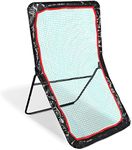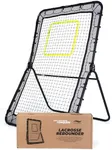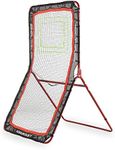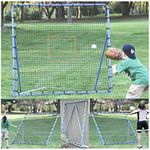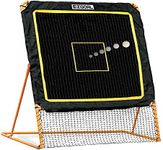Buying Guide for the Best Lacrosse Rebounders
Choosing the right lacrosse rebounder can make a big difference in your practice sessions, whether you’re a beginner or an experienced player. A rebounder helps you improve your passing, catching, and shooting skills by bouncing the ball back to you, simulating real game situations. When shopping for a lacrosse rebounder, it’s important to consider several key features to ensure you get one that matches your skill level, available space, and training goals.Rebound Surface SizeThe rebound surface size refers to the area of the net that actually bounces the ball back to you. A larger surface gives you more room for error and is great for beginners or those who want to practice a variety of shots and passes. Smaller surfaces are more challenging and help advanced players work on accuracy. If you’re just starting out or want to use the rebounder for multiple drills, a bigger surface is helpful. If you’re looking to sharpen your precision, a smaller target might be better.
Frame DurabilityFrame durability is about how strong and sturdy the rebounder’s structure is. A durable frame, often made from steel or heavy-duty metal, will withstand repeated impacts and outdoor weather. Lighter frames are easier to move but may not last as long, especially with frequent use. If you plan to leave your rebounder outside or use it often, look for a robust, weather-resistant frame. For occasional or indoor use, a lighter frame might be sufficient.
AdjustabilityAdjustability means how much you can change the angle or position of the rebounder’s net. Some rebounders let you set different angles to practice ground balls, high passes, or unpredictable bounces. More adjustability gives you a wider range of training options and can keep practice interesting. If you want to work on multiple skills or share the rebounder with players of different levels, choose one with easy angle adjustments. If you only need it for basic drills, a fixed-angle model may be enough.
PortabilityPortability refers to how easy it is to move or store the rebounder. Some models fold up or have wheels, making them simple to transport or put away when not in use. If you have limited space or need to move the rebounder between locations, portability is important. If you have a dedicated practice area and don’t plan to move it, a heavier, stationary model could work well.
Net QualityNet quality is about the material and construction of the net that rebounds the ball. A high-quality net will last longer and provide a consistent bounce, while lower-quality nets may wear out quickly or lose their tension. If you plan to use the rebounder frequently or with high-speed shots, look for a net made from strong, weather-resistant materials. For light or occasional use, a basic net may be sufficient.
